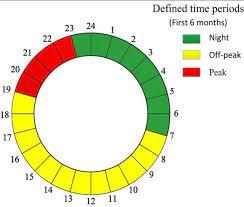Last summer, Emily thought she was being smart about her electricity bill. She ran her dishwasher at night, used her AC moderately, and turned off lights religiously. Yet, when the bill arrived, it was higher than ever. What she didn’t realize was that her local utility company had switched her to time-of-use (TOU) electricity rates—a plan that charges more during “peak hours” and less when demand drops.
Emily’s story isn’t unique. Across the U.S., millions of homeowners are unknowingly losing hundreds, even thousands, of dollars each year because they don’t understand how TOU pricing really works. So, how much money are you losing on time-of-use electricity rates? Let’s break it down.
Understanding Time-of-Use Electricity Rates
What Are Time-of-Use Rates?
Time-of-use electricity rates are pricing structures where the cost of electricity changes based on the time of day. Utilities charge more when demand is highest—usually late afternoon to evening—and less when usage drops overnight or mid-day.
For example:
- Peak hours (4 p.m.–9 p.m.): Highest rates
- Off-peak hours (9 p.m.–6 a.m.): Lowest rates
- Mid-peak (6 a.m.–4 p.m.): Moderate rates
The goal is to encourage people to shift usage away from high-demand periods. But unless you actively track your energy patterns, it’s easy to end up paying more instead of saving.
Why TOU Pricing Might Be Costing You More
1. Lifestyle Doesn’t Match the Rate Schedule
Most people use the most electricity when rates are highest—cooking dinner, doing laundry, or running air conditioning in the evening. If your daily habits fall in the “peak zone,” you’re automatically spending more.
2. Smart Homes Aren’t Always Smart
Even with smart thermostats or automated schedules, if your devices aren’t synced to TOU hours, your savings could vanish. Many homeowners assume automation equals efficiency—but automation at the wrong time can double costs.
3. Hidden Fees and Adjustments
Some utility companies introduce TOU plans with introductory discounts that disappear after the first year. Others apply demand charges or minimum usage fees that quietly inflate your bill.
So, how much money are you losing on time-of-use electricity rates? The answer could be anywhere from 10% to 40% more than you’d pay on a standard flat-rate plan, depending on your habits and appliances.
Real Numbers: The Cost Difference
Let’s do a quick comparison.
| Plan Type | Average Cost per kWh | Monthly Usage | Monthly Bill |
| Flat Rate | $0.15 | 1,000 kWh | $150 |
| TOU Plan (mixed use) | Peak: $0.30 / Off-peak: $0.10 | 1,000 kWh | $180–$200 |
Even a small shift in when you use energy can dramatically affect your costs. And because most families use more power during expensive hours, TOU plans often lead to unexpected increases rather than savings.
How to Beat the TOU System
1. Shift Your Energy Use
Move heavy energy tasks—laundry, dishwashing, EV charging—to off-peak hours. Most utilities provide charts or apps showing your local TOU schedule.
2. Upgrade to Smart Energy Storage
Solar batteries have become the ultimate solution to TOU pricing. With solar panels and battery storage, you can generate and store cheap, daytime energy and use it during peak hours when grid prices spike.
Imagine powering your evening routine entirely on stored sunlight. You avoid peak rates and reduce dependence on the utility grid altogether.
3. Install Real-Time Monitoring
Smart energy monitors track consumption in real time and alert you when you’re entering peak rate windows. This awareness alone can cut 10–15% off your bill.
Solar + Battery: The Game Changer
Homeowners using solar plus battery storage can eliminate the impact of TOU rates entirely. Here’s how:
- Charge during off-peak hours or via solar panels
- Discharge stored power during peak hours
- Avoid grid electricity when rates are highest
Essentially, you create your own personal rate plan—independent of utility fluctuations.
When paired with incentives and rebates, battery storage can pay for itself in as little as 5–7 years, while protecting you from rising utility rates for decades.
Should You Switch Away from TOU?
Not necessarily. TOU plans can work in your favor if you understand them. Night owls, remote workers, or solar homeowners can actually benefit. But if your schedule locks you into peak-hour usage, you’re probably losing money every month.
So, how much money are you losing on time-of-use electricity rates? For most families, the answer ranges from a few hundred to over a thousand dollars annually—money that could easily be saved with better energy planning or solar battery adoption.
Conclusion
Time-of-use rates were designed to promote smarter energy use—but without the right strategy, they can quietly drain your wallet. Whether you shift your habits, adopt real-time monitoring, or go solar with battery backup, the power to save is literally in your hands.
Stop letting the clock control your costs. Once you understand how much money you are losing on time-of-use electricity rates, you can finally flip the switch—from being overcharged to being empowered.

